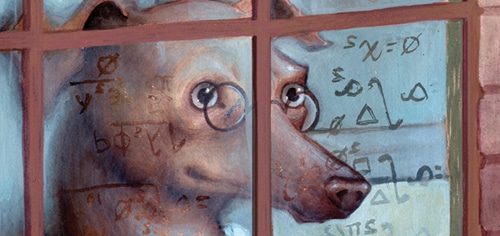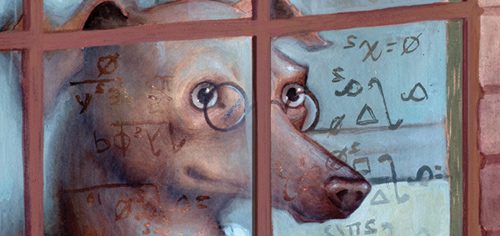

The Dogs Most Likely to Show Mental Decline with Age
A study of over 15,000 dogs pinpoints which factors—besides age—contribute to a dog’s loss of mental ability
As your dog grows older, you might notice lapses in memory and other behavioural changes. Similar to aging in people, older dogs can suffer from a disorder called Canine Cognitive Dysfunction or CCD, which is often compared to Alzheimer’s Disease in humans because the symptoms are similar. These include forgetfulness, disorientation, not recognizing family members, sleep disruption, and other lapses in normal mental behaviour. Not only are the dog’s behavioral symptoms similar to that of people with Alzheimer’s disease, the changes that occur in the aging dog’s brain are also similar. At the neurological level, the similarities between Alzheimer’s disease and CCD are quite marked, with both showing changes in the brain involving tangled clumps of neural tissue known as beta-amyloid plaques.
A New Study of Canine Cognitive Dysfunction
The effect of CCD on the quality of a dog’s life and its relationship with its owner is as devastating as the effects of Alzheimer’s disease on the quality of human life and family relationships. There have been a number of studies that have looked at CCD, but most of them have been limited in size, so that broad conclusions, such as determining which dogs are most likely to come down with the problem, could only be tentatively made. However, a new study by Sarah Yarboroughof the Department of Epidemiology at the University of Washington has now provided some answers that allow us to predict which dogs are most susceptible to the mental decline associated with CCD.
In terms of numbers, this study is huge, comprised of 15,019 dogs. The data were obtained from the National Institute on Aging’s nationwide longitudinal study on canine aging and mortality. The Dog Aging Project (DAP) was started in 2018. The study included administration of a number of surveys, including the Health and Life Experience Survey, which gathers a lot of health data and includes sections on dog and owner household demographic characteristics, dog physical activity, environment, behaviour, diet, medications and preventatives, and health status. In addition, participants were given the Canine Social and Learned Behaviour Survey, which is used to assess whether there is any mental decline in dogs associated with CCD. Scores for this survey were split into two groups, and dogs with a score at or above 50 were classified as having Canine Cognitive Dysfunction.
CCD is a disease of older dogs, so it is not surprising that age is an important factor in increasing the likelihood of its appearance. The increasing risk, however, is quite large. When controlling for all other characteristics, the odds of CCD increased 52 percent with each additional year of age. However, a number of factors play a role in susceptibility.
Canine Cognitive Dysfunction: It’s Not All a Matter of Age
This study notes that poor overall health, including a number of different diseases and conditions, can slightly increase the risk of CCD. However, two sensory conditions pose a more significant risk. At any given age, dogs that have a history of neurological eye or ear disorders were found to be approximately twice as likely to be classified as having CCD. Similar findings have been found in humans, since individuals with marked hearing loss or diminished visual ability have been shown to be more likely to be diagnosed with Alzheimer’s disease.
By keeping aging dogs mentally active, the effects of age-related mental deterioration on learning and problem-solving can be greatly slowed, or even reversed.
Although sex did not have much of an effect, sexual status did. When a comparison was made between dogs that were spayed or neutered versus those which were sexually intact, it was found that the intact dogs were 64 percent less likely to be classified as having CCD.
Breed Matters
Since it is known that in humans, genetics plays a role in your susceptibility to any form of dementia, it is a good guess that there would be differences among dog breeds. When the participant dogs were divided by breed it was found that breed group was an important predictor. Using American Kennel Club group designations, those dogs classified as terriers, toys or in the non-sporting group were more than three times as likely to be diagnosed with Canine Cognitive Dysfunction compared to the other breed groupings.
Causes and Preventative Measures
Nobody knows for sure what causes Alzheimer’s disease or Canine Cognitive Dysfunction, however, evidence has accumulated which suggests that an individual’s lifestyle may be important. One of the most significant factors in avoiding the decline in thinking ability involves keeping mentally active. In humans, people who engage in challenging mental activities, such as solving crossword puzzles, playing games, engaging in new activities, taking courses, traveling, reading, or engaging in social activities, tend to be more likely to avoid the usual age-related decline in mental ability. Norton Milgram of the University of Toronto has demonstrated that by keeping aging dogs mentally active (in his lab he uses Beagles), the effects of age-related mental deterioration on learning and problem-solving can be greatly slowed, or even reversed.
At home, setting up new problems and experiences to keep your dog’s aging brain from deteriorating can be a bit challenging. However, if we consider how and why evolution developed brains in the first place, a simpler, practical, alternative solution suggests itself.

Photo: graphicphoto/bigstock.com
If we could jump back into the dim past, say half a billion years ago, we would see the first nervous systems starting to appear. The original purpose for a nervous system was to coordinate movement so an animal could go find food, instead of waiting for the food to come to it. Jellyfish are similar to the first animals that evolved connected patterns of nerve cells to communicate to their musculature. This gave them a tremendous advantage over animals like sponges and sea anemones that waited brainlessly for dinner to arrive. It can be shown that animals which move quickly and frequently tend to have larger and more complex brains than similar classes of animals which are not as active. After millions of years of evolutionary experiment, nervous systems evolved some complex ways of going out to eat. However, the goal of the brain remains the same, namely to coordinate movements. In this context, it is interesting to note that a diminished ability to move is a good indication of the effects of aging. You might say that inflexibility heralds the approach of death, while a flexible body that is capable of making fluid movements, which must be synchronized by an agile, active brain are the hallmarks of youth.
Walking Away from Mental Declines in Aging
If this line of reasoning is correct, then perhaps increasing physical activity may help to strengthen the brain and offset the effects of aging in the same way that increasing mental activity does. This seems to certainly be true for human beings. Studies of senior citizens who walk regularly showed significant improvement in memory skills compared to sedentary elderly people. Walking also improved their learning ability, concentration, and abstract reasoning in people who walked as little as 20 minutes a day. Furthermore, research from the Salk Institute demonstrates that physical exercise has a protective effect on the brain and its mental processes, and may prevent Alzheimer’s disease. Their data was based on exercise and health data from nearly 5,000 men and women over 65 years of age and it showed that those who exercised were less likely to lose their mental abilities or develop any form of dementia, including Alzheimer’s.
This latest study on CCD seems to confirm that activity level has similar effects on the canine brain. Specifically, it found that among dogs of the same age, health status, breed type, and sterilization status the odds of showing Canine Cognitive Dysfunction were a startling 6.47 times higher in dogs that were not active, compared to those who were very active.
So the implications appear to be quite clear. If you have an aging dog and you want to offset the kinds of mental declines that we normally expect in older canines, or even if you have a senior dog who is beginning to show signs of memory loss or other symptoms of Canine Cognitive Dysfunction, a simple way to slow the deterioration of his mind and perhaps offset the effects of aging involves simply clipping a leash onto your dog’s collar and taking a walk. The more frequently you walk, and the longer the walks, the slower the mental decline with age. By the way, that same research suggests that your brain will also reap similar benefits and give you the same protection from aging-related mental decline that your dog gets while you are walking him.
Join the newsletter and never miss out on dog content again!
"*" indicates required fields
By clicking the arrow, you agree to our web Terms of Use and Privacy & Cookie Policy. Easy unsubscribe links are provided in every email.






